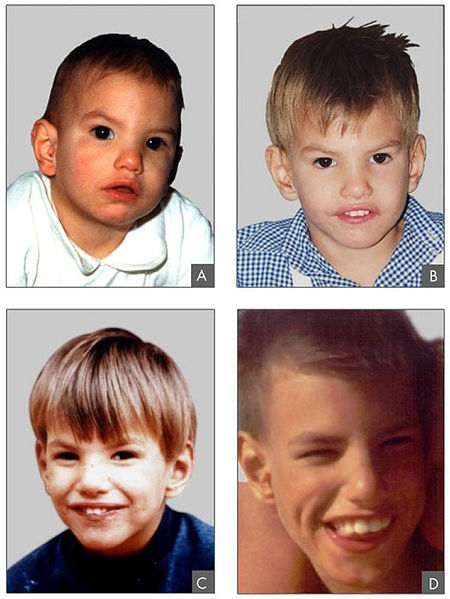Cri Du Chat Syndrome

Cri du chat syndrome is a rare, genetic medical issue that is present at birth and detrimentally impacts the growth and development. It occurs when a variable-based portion of the short arm associated with chromosome 5 is either missing or completely deleted. Symptoms range greatly from one person to another. Those experienced depend upon the size and the exact location of the genetic material that is missing or deleted. While it is true that doctors have learned quite a bit about cri du chat syndrome, it is still considered to be one of the greatest of all mysteries in the medical field.
The Story Behind the “Cri Du Chat” Name
“Cri du chat” translates from French to English and means “cry of the cat”. This syndrome was first mentioned in the year of 1963 in medical literature. Dr. Lejeune named the syndrome cri du chat because of the fact that those that have the condition have a very distinctive cry that resembles that of a cat. In fact, the high-pitched and the shrill-like cry is the characteristic symptom of infants with the condition. This mewing, cat-like sound occurs in the first few weeks of life. As an infant grows, the cry becomes less pronounced.
There are many synonyms associated with cri du chat syndrome. These currently include the following:
· Cat Cry Syndrome
· Cat’s Cry Syndrome
· 5p- Syndrome
· 5p Minus Syndrome
· CdCS
· Lejeune Syndrome
Is Cri Du Chat Inherited?
In most instances, cri du chat is not an inherited condition. It is believed that the deletion that causes the syndrome stems from a random event that occurs in the formation process of the sperm cells, eggs, or within the time where the embryo is in its earliest development. Approximately 10% to 15% inherit a chromosomal-based abnormality from a parent.
These parents carry a rearrangement of the chromosome called balanced translocation. This does not involve the loss or the gain of genetic material; however, when passed on to children, it could result in an unbalanced translocation where there is either additional genetic material or missing genetic material. In the case of cri du chat, genetic material is missing from the chromosome 5 short arm.
What are the Signs and Symptoms of Cri Du Chat Syndrome?
The signs and symptoms associated with cri du chat syndrome vary from one individual to another. The cat-like cry is the most common of all symptoms. In addition to this, the following may indicate the presence of this syndrome:
1. Low Birth Weight
2. Deficiencies in Growth
3. Diminished Tone of the Muscles (Hypotonia)
4. Unusually Small Head (Microcephaly)
5. Unusually Round Face
6. Eyes Spaced Widely Apart
7. Exceptionally Broad Nasal Bridge
8. Crossed Eyes
9. Eyelid Folds That Slant Downwards (Palpebral Fissures)
10. Vertical-Based Skin Folds That Cover Inner-Eye Corners (Epicanthal Folds)
11. Unusually Small Jaw (Micrognathia)
12. Ears That Are Set Low
13. Improper Upper and Lower Teeth Alignment (Malocclusion)
14. Shortened Distance from Upper Lip to Nose (Short Philtrum)
15. Cleft Palate
16. Cleft Lip
17. Abnormal Lower Lip Fullness
18. Split Uvula in Back of Throat (Bifid Uvula)
19. Development of a Long and Narrow Face as Infant Ages
20. Psychomotor Disability
21. Intellectual Disability
22. Delayed Speech Development
23. May be Hyperactive
24. May Exhibit Behavior Issues
25. May Experience Problems Feeding
26. May be at High Risk for Aspiration
27. Due to Increased Aspiration Risk, an Increased Risk for Developing Pneumonia
28. Side-to-Side Spine Curvature (Scoliosis)
29. Higher Risk of Ear Infections and Hearing Loss
30. Many Have Congenital Heart Defects and Underlying Health Issues with Various Components of the Body and Organs

Clinical features of a patient with Cri du Chat syndrome at age of 8 months (A), 2 years (B), 4 years (C) and 9 years 6/12 (D) Source/Credit: Paola Cerruti Mainardi. Cri du Chat syndrome. Orphanet Journal of Rare Diseases. 1, 33. 2006.
How is a Cri Du Chat Diagnosis Made?
In newborns, a diagnosis of cri du chat syndrome may be confirmed by the performing any or all of the following:
· Clinical Evaluation
· Chromosomal Studies
· The Identification of Characteristic Signs and Symptoms
· The Fluorescence in Situ Hybridization (FISH) Test
· X-Rays to Determine Skeletal Abnormalities
How is Cri Du Chat Syndrome Treated?
The treatment of cri du chat syndrome involves an intense focus on managing the symptoms experienced. In some instances, a doctor may be all that is needed. In others, a health care team that involves numerous specialists may be required. The following outlines the types of professionals that may be on this type of care team:
· Geneticist
· Pediatrician
· Cardiologist
· Orthopedist
· Speech Pathologist
· Surgeon
· Physical Therapist
· Occupational Therapist
· Ear, Nose, and Throat (ENT) Specialist
· Behavior Specialist
· Dentist
· Psychiatrist
· And, more!
For children that are born with cri du chat syndrome, early intervention is the key to that child reaching their absolutely highest potential. Genetic counseling is recommended for families experiencing this syndrome. Symptomatic and supportive therapies are also encouraged.
Is Cri Du Chat Syndrome Preventable?
No, cri du chat is not preventable. To date, there is no known strategy for avoiding the development of this issue. If you have a family history of this condition, you may be a carrier; however, many potential causes of the development of this syndrome have nothing to do with genetics.
Is Cri Du Chat Syndrome Life-Threatening?
Cri du chat may cause numerous anomalies in the body that prove detrimental to the health. Organ defects – especially those involving the kidneys and the heart – may be present and prove to be life-threatening. Complications that are fatal will typically make themselves known by the first birthday. If a child reaches this milestone, it is quite likely that they will have a normal life expectancy.
Prevalence of Cri Du Chat Syndrome
Cri du chat is considered to be rare. It affects 1 in every 37,000 or 1 in every 50,000. It most commonly occurs in females, but also affects males.
Genetic Facts Relating to Cri Du Chat Syndrome
Cri du chat develops due to missing information on the chromosome 5 small arm. The size of the missing information – also referred to as the “deletion” – varies from one individual to another. It has been established that there is a region considered to be critical on the chromosome 5 that appears to directly relate to the features of the syndrome.
This area has been identified as “Region 5p15.2”. The following area, “Region 5p15.3” also causes certain characteristics in sufferers. Examples include the cry that resembles the cat dry and the issue of speech delay and associated complications. For more detailed information on the genetics behind this condition, we advise seeking the assistance of a genetic counselor.
What Causes the Distinctive Cat-Like Cry in Cri Du Chat Syndrome?
The cat-like cry is considered to be the core characteristic of cri du chat syndrome. It is believed that it occurs because of anomalies within the larynx. This is often small and shaped like a diamond. It is also believed that anomalies within the cartilage that are situated behind the tongue and directly to the front of the larynx are to blame. This is smaller and a bit more floppy-like than in infants that do not have the condition.
Support and Resources
There are numerous support groups and available resources for families who are coping with cri du chat syndrome. The following provides an outline of these. Simply click on the links below to learn more:
The National Organization for Rare Disorders, Inc.
Cri Du Chat Research Foundation
The American College of Medical Genetics
The National Society of Genetic Counselors

Return to Cri Du Chat Top of Page
Return to Greatest Unsolved Mysteries Home Page
Explore the Index of Greatest Unsolved Mysteries
Copyright © 2009-2022 Greatest-Unsolved-Mysteries.com. All Rights Reserved


